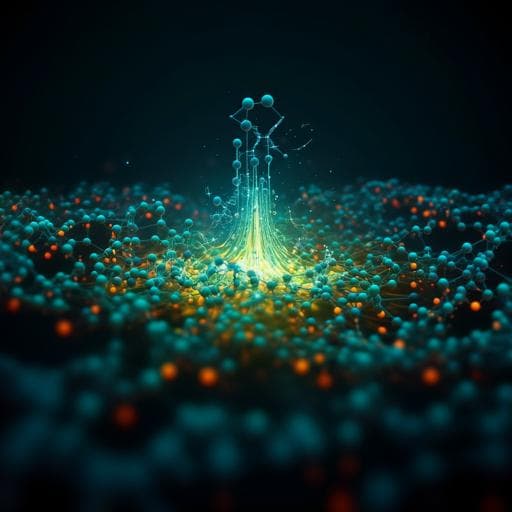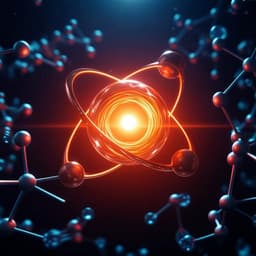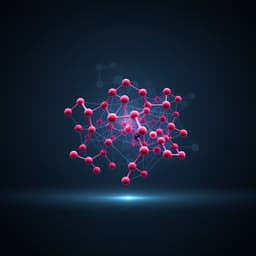
Chemistry
Electrocatalytic synthesis of adipic acid coupled with H₂ production enhanced by a ligand modification strategy
Z. Li, X. Li, et al.
Discover an innovative electrocatalytic strategy for producing adipic acid while generating H₂, leveraging a sodium dodecyl sulfonate-modified nickel hydroxide catalyst. With a remarkable increase in productivity and faradaic efficiency, the research conducted by Zhenhua Li, Xiaofan Li, Hua Zhou, Yan Xu, Si-Min Xu, Yue Ren, Yifan Yan, Jiangrong Yang, Kaiyue Ji, Li Li, Ming Xu, Mingfei Shao, Xianggui Kong, Xiaoming Sun, and Haohong Duan promises exciting advancements in sustainable chemistry.
~3 min • Beginner • English
Introduction
The study addresses the environmental and operational drawbacks of the current industrial adipic acid synthesis, which oxidizes KA oil with concentrated nitric acid, producing corrosive conditions and significant N₂O emissions. The research aims to develop a sustainable electrochemical pathway to convert cyclohexanone/cyclohexanol to adipic acid under mild conditions while co-producing hydrogen. A key challenge is the low solubility and poor mass transfer of cyclohexanone in aqueous electrolytes, which limits adsorption and reaction rates on catalyst surfaces. The authors hypothesize that engineering catalyst surface hydrophobicity via interlayer ligand (surfactant) modification can enrich immiscible substrates at active sites and enhance electrocatalytic oxidation performance. They employ SDS-intercalated α-Ni(OH)₂ to test this hypothesis and seek to demonstrate efficiency, selectivity, stability, mechanistic basis, and practical operation in a flow electrolyzer.
Literature Review
Prior electrocatalytic oxidation of KA oil to adipic acid over NiOOH achieved 52% yield at 6 mA cm⁻² (Lyalin and Petrosyan, 2004). More recent work with Mn-doped Co oxyhydroxide reached 64.2% yield, though activity and rates remain limited, largely due to mass transfer constraints from substrate immiscibility. In related electrochemical contexts, constructing hydrophobic ligand-modified interfaces has improved enrichment and reactivity of poorly soluble species: ordered-ligand interlayers enhanced CO₂ reduction to CO; surfactant-modified PbO₂ improved electrochemical degradation of organics in water. However, such ligand modification strategies have rarely been applied to electrocatalytic conversion of immiscible liquid substrates in aqueous media. This work builds on these insights, targeting enhanced enrichment and oxidation of cyclohexanone by intercalating surfactants into layered hydroxide catalysts.
Methodology
- Catalyst synthesis: SDS-intercalated α-Ni(OH)₂ (Ni(OH)₂-SDS) was grown on Ni foam via hydrothermal synthesis using Ni(NO₃)₂·6H₂O, NH₄F, urea, and SDS at 100 °C for 10 h. Pure Ni(OH)₂ was prepared identically without SDS. Additional intercalated samples with varying alkyl chain lengths (Ni(OH)₂-C₄, C₈, C₁₂=SDS, C₁₆) were synthesized by replacing SDS with sodium butyl/octyl/hexadecyl sulfate.
- Structural and surface characterization: XRD to confirm α-Ni(OH)₂ and interlayer expansion (003 peak shift; interlayer ~2.95 nm for SDS); SEM and (HAADF-)STEM-EDS for morphology and elemental mapping; HRTEM for lattice spacings ((003) ~2.9 nm; (015) 0.23 nm); FTIR for SDS signatures (methylene and sulfate bands); XPS to confirm S in Ni(OH)₂-SDS; contact angle to assess hydrophobicity; ICP-OES to estimate SDS-to-Ni coordination (ca. 1:23.3 on one side of layer).
- Electrochemical testing (three-electrode, membrane-free beaker): Electrolyte 0.5 M KOH at room temperature; Ag/AgCl reference, Pt counter. LSV (10 mV s⁻¹) with and without substrate; chronoamperometry at fixed potentials (e.g., 1.5 V vs RHE) with stirring at 800 rpm; normal pulse voltammetry (NPV) to probe mass transfer–limited behavior. In situ Raman to monitor Ni(OH)₂ ⇌ NiOOH transformation during operation.
- Product analysis and FE: HPLC (Coregel 87H, 5 mM H₂SO₄ mobile phase, UV 210 nm and RI detection) for acids; ¹H NMR for cyclohexanone/cyclohexanol; FE calculated from charge passed and stoichiometry. Oxygen evolution quantified by optical O₂ probe in airtight cell.
- Adsorption/enrichment and active site quantification: Quartz crystal microbalance (QCM) to measure mass uptake upon cyclohexanone addition; in situ FTIR to probe substrate adsorption; pulsed chronoamperometry to quantify reducible/active Ni sites; ECSA estimation from capacitive currents. Isotope labeling (D₂O, H₂¹⁸O) with GC-MS to probe mechanism (keto-enol tautomerism/ketone hydration).
- Simulations and theory: Coarse-grained MD (GROMACS, MARTINI force field) to model SDS intercalation and cyclohexanone diffusion/enrichment relative to pure Ni(OH)₂; energy evolution and radial distribution analyses. Spin-polarized DFT to compute adsorption energies of cyclohexanone in Ni(OH)₂-SDS vs water and assess release feasibility.
- Universality tests: Evaluate different intercalated ligand chain lengths (C₄–C₁₆), multiple substrates (immiscible: cyclobutanone, cyclopentanone, cycloheptanone, benzaldehyde; miscible: methanol, ethanol, ethylene glycol, glycerol), and other layered hydroxides (Co(OH)₂, CoMn-, NiCo-, NiFe-LDHs).
- Flow electrolyzer (two-electrode, membrane-free): Custom 36 cm² cell, Ni(OH)₂-SDS anode and Ni foam cathode, circulating electrolyte (0.5 M KOH + 50 mM cyclohexanone) at 3 mL min⁻¹ via peristaltic pump. LSV to determine operating window; galvanostatic operation at 0.5–1.2 A for 1 h tests and long-term 24 h at 0.8 A (30 mA cm⁻²). Adipic acid quantified by HPLC; H₂ volume measured at cathode.
Key Findings
- Performance boost via SDS intercalation: Ni(OH)₂-SDS delivered 3.6-fold higher adipic acid productivity than pure Ni(OH)₂, reaching 90 µmol cm⁻² h⁻¹ at 1.5 V vs RHE (1 h), with adipic acid FE up to 93% (vs 56% for Ni(OH)₂).
- Kinetics and yield: Under higher conversion, cyclohexanone conversion was nearly complete by 16 h with adipic acid yield of 84%. For cyclohexanol, rapid oxidation to cyclohexanone and onward to adipic acid achieved 86.5% yield in 25 h at 1.5 V vs RHE.
- Stability: Ni(OH)₂-SDS maintained productivity and selectivity over 10 batches (20 h total). Morphology and intercalated SDS preserved; active Ni site count unchanged post-reaction; SDS leaching negligible (~−0.8%).
- Mechanism of enhancement: In situ Raman indicated NiOOH as the active phase; SDS did not enhance intrinsic Ni(OH)₂→NiOOH conversion or alter Ni coordination significantly (EXAFS). Pure Ni(OH)₂ had more reducible Ni sites than Ni(OH)₂-SDS, excluding increased site exposure as the cause. After normalizing by reducible Ni sites, productivity was 269 vs 56 µmol cm⁻² h⁻¹ C⁻¹ for Ni(OH)₂-SDS vs Ni(OH)₂ (4.8×), confirming SDS-induced mass transfer/enrichment effects.
- Mass transfer and adsorption: NPV showed pure Ni(OH)₂ reached a mass-transfer-limited plateau >1.4 V vs RHE, while Ni(OH)₂-SDS continued to increase without plateau. QCM revealed 2.5× greater mass gain upon cyclohexanone addition for Ni(OH)₂-SDS, evidencing enhanced adsorption. CA traces showed Ni(OH)₂-SDS sustained current vs rapid decay on Ni(OH)₂.
- Simulations and DFT: CGMD demonstrated cyclohexanone accumulates at edges/interlayer vicinity of Ni(OH)₂-SDS, with decreasing interaction energy over time; radial distributions confirmed edge enrichment. DFT showed stronger adsorption in Ni(OH)₂-SDS than water (Eads −0.46 vs −0.17 eV), but differential adsorption (−0.29 eV) allows substrate release at room temperature under reaction conditions.
- Reaction pathway: Evidence supports tandem nucleophilic oxidation: cyclohexanol → cyclohexanone (over NiOOH), then base-promoted keto-enol tautomerism/ketone hydration to intermediates (enol/gem-diol), formation of O-centered radicals and hydroxy cyclohexanone, then cyclohexane-1,2-dione intermediate oxidized to adipic acid. Glutaric acid forms at high potentials via a 1,3-dione route.
- Universality: Intercalating alkyl sulfates (C₄–C₁₆) expanded interlayer spacing from 0.76 to 3.36 nm and enhanced Ni-site-normalized productivities vs pure Ni(OH)₂. SDS intercalation improved oxidation of immiscible substrates (cyclobutanone, cyclopentanone, cycloheptanone, benzaldehyde), increasing current and FE; no significant gain for miscible substrates (methanol, ethanol, ethylene glycol, glycerol). Extends to other layered hydroxides (Co(OH)₂, CoMn-, NiCo-, NiFe-LDHs).
- Practical flow operation: In a membrane-free flow electrolyzer (36 cm²), LSV reached 4.5 A at 2.9 V with 50 mM cyclohexanone in 0.5 M KOH, exceeding current in blank electrolyte. At 0.8 A (30 mA cm⁻²) for 24 h, produced 4.7 mmol adipic acid (64% yield) and 8.0 L H₂. Higher current increased OER competition, reducing FE/productivity beyond 0.8 A.
Discussion
The work directly tackles the mass transfer limitation arising from cyclohexanone’s immiscibility in aqueous base by engineering the catalyst microenvironment. Intercalated SDS creates a hydrophobic domain within α-Ni(OH)₂ that enriches cyclohexanone at the nanosheet edges where NiOOH active sites reside, accelerating substrate delivery without increasing intrinsic activity or active site density. Electroanalytical (NPV, CA), QCM adsorption, in situ spectroscopy, and CGMD converge to show that enhanced edge accumulation and improved diffusion underpin the 3.6× productivity gain and high FE (93%), suppressing competing OER at moderate potentials. The mechanistic proposal for KA oil oxidation integrates base-assisted keto-enol/ketone-hydration equilibria with NiOOH-mediated nucleophilic dehydrogenation steps, rationalizing observed intermediates and side products. The approach generalizes across surfactant chain lengths, immiscible aldehydes/ketones, and various layered hydroxide hosts, indicating broad relevance for electrooxidation of poorly soluble substrates. Demonstration in a membrane-free flow electrolyzer with concurrent H₂ production highlights translational potential, though process optimization (e.g., substrate feed management, separation) remains necessary for scale-up.
Conclusion
This study introduces a ligand-intercalation strategy to enhance electrocatalytic oxidation of immiscible substrates by enriching them at active sites within layered hydroxide catalysts. SDS-intercalated α-Ni(OH)₂ achieves high adipic acid selectivity and productivity (FE up to 93%, 3.6× activity vs unmodified Ni(OH)₂), robust stability, and effective operation in a practical flow cell co-producing H₂. Mechanistic analyses attribute performance gains to SDS-enabled substrate enrichment and mass transfer facilitation at nanosheet edges rather than to increased intrinsic activity or site density. The strategy generalizes across surfactant chain lengths, substrates, and layered materials, offering a platform approach for upgrading immiscible molecules in aqueous electrosynthesis. Future work should optimize high-concentration feeds and mitigate phase separation (e.g., mixed solvents), develop integrated separation such as electrodialysis-coupled systems for product recovery and alkali recycle, and refine multiscale models to better capture interlayer/edge transport phenomena.
Limitations
- Substrate immiscibility at higher concentrations can cause phase separation; mixed solvent strategies and reactor engineering are needed for practical feeds.
- Product separation and alkali recycle remain nontrivial; while an EC–ED concept is proposed, its feasibility and economics require further validation.
- At higher anodic currents/potentials, OER competes, lowering FE and productivity; operating windows must be optimized.
- Simulations used coarse-grained models and limited timescales; more precise structural models and longer times may better capture interlayer transport and swelling effects (though XRD showed no swelling under tested conditions).
- Minor SDS detachment at reconstructed edge Ni sites was observed but did not significantly impact performance; long-term (>100 h) durability and surfactant retention under varied conditions need assessment.
Related Publications
Explore these studies to deepen your understanding of the subject.







